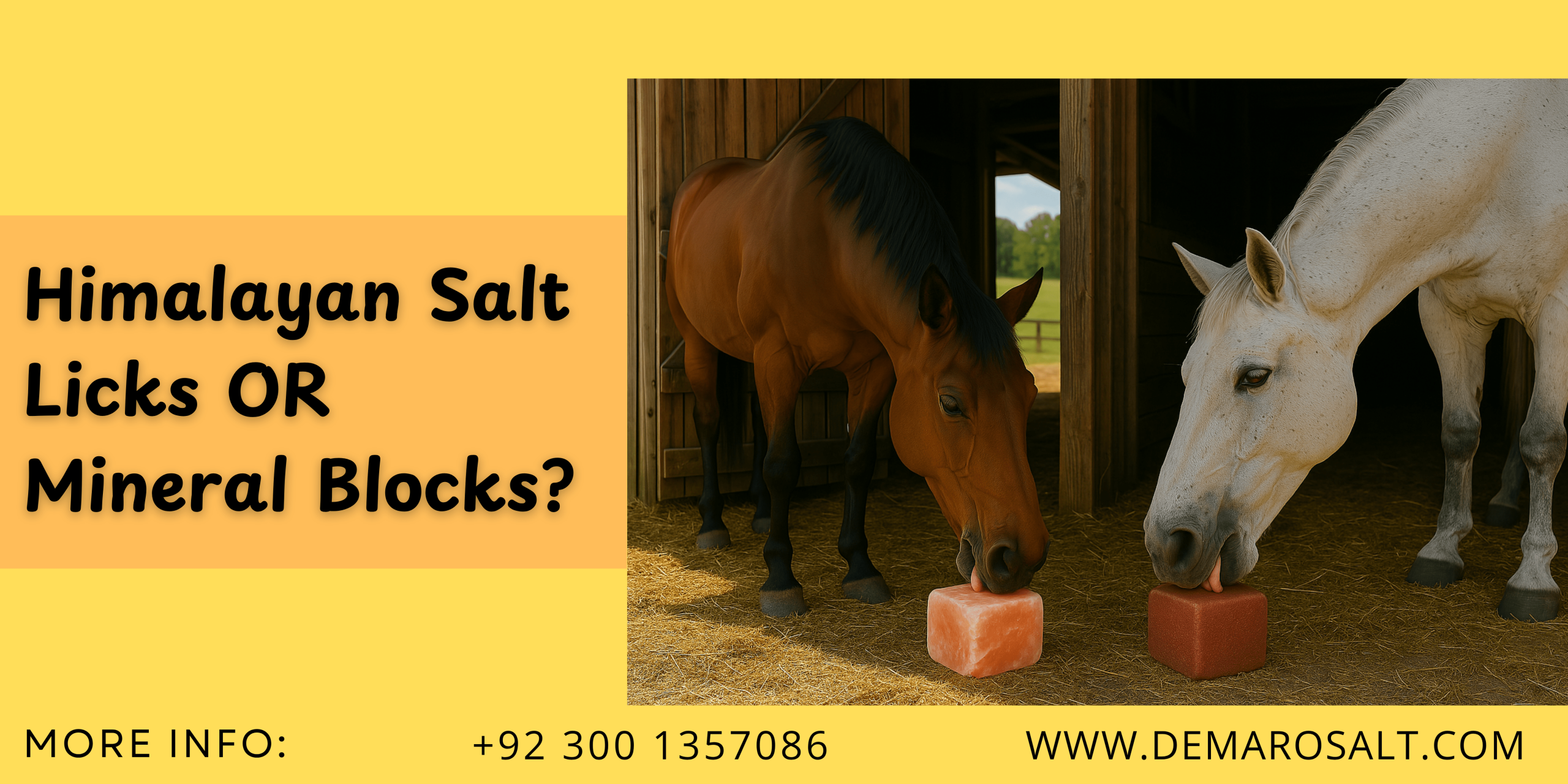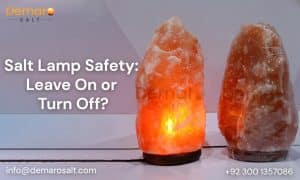Table of Contents
Himalayan Salt Licks vs. Mineral Blocks is a common comparison for livestock owners aiming to maintain optimal health in horses and other animals. Both serve as essential mineral supplements—but each has distinct advantages. Choosing the right option depends on your animals’ nutritional needs, farm conditions, and management goals. In this blog, we’ll explore the differences between Himalayan salt licks and mineral blocks to help you make a confident and informed decision.

What Are Himalayan Salt Licks?
Himalayan salt licks are solid blocks of natural pink salt mined from ancient deposits in the Himalayan region. They contain over 80 trace minerals such as magnesium, calcium, and potassium. With no chemical additives or artificial flavors, these salt licks offer a natural and long-lasting mineral source for animals.
What Are Mineral Blocks?
Mineral blocks are manufactured supplements made by compressing a blend of minerals, vitamins, and sometimes molasses. They are designed to address specific dietary deficiencies in livestock. Mineral blocks vary in formulation and can be customized for different species and regions.
Key Differences at a Glance
Feature | Himalayan Salt Licks | Mineral Blocks |
Origin | Natural (Himalayas) | Manufactured |
Mineral Content | 80+ trace minerals | Custom-formulated minerals |
Additives | None | Sometimes included |
Durability | Very long-lasting | Can wear down quickly |
Usage | All-purpose, natural option | Specific nutritional needs |
Pros & Cons: Himalayan Salt Licks
Pros:
– 100% natural and chemical-free
– Highly durable in various climates
– Rich in essential trace minerals
– Safe for multiple species
Cons:
– No custom mineral formulation
– Very hard texture may not suit all animals
Pros & Cons: Mineral Blocks
Pros:
– Targeted for specific deficiencies
– Often flavored for palatability
– Available in different sizes and hardness levels
Cons:
– May contain artificial additives
– Less weather-resistant
– Shorter lifespan compared to Himalayan salt licks
Which Is Better for Horses?
When comparing Himalayan salt licks vs. mineral blocks for horses, your decision depends on the horse’s lifestyle and health requirements. Performance horses may benefit from mineral blocks with added electrolytes. However, Himalayan salt licks remain a favorite for natural supplementation and behavioral enrichment.
Which Is Better for Other Livestock?
For goats, cattle, and sheep, both options have their benefits. Himalayan salt licks offer a natural source of trace minerals and are safe for communal use. Mineral blocks are more effective for correcting specific mineral imbalances in animals with higher dietary demands. Always ensure species-appropriate blocks are used—especially with copper-sensitive animals like sheep.
How to Make the Right Choice
To choose between Himalayan salt licks vs. mineral blocks, consider the following factors:
– Budget and frequency of replacement
– Animal species and dietary needs
– Indoor vs. outdoor placement
– Availability of water sources nearby
FAQs: Salt Licks vs Mineral Blocks
Q1: Can I offer both Himalayan salt licks and mineral blocks to the same animal?
A1: Yes, many farm owners provide both, allowing animals to self-regulate their intake based on need.
Q2: Are there risks to using mineral blocks?
A2: Only if overused or shared between incompatible species. Always monitor usage and select the right type.
Q3: Do Himalayan salt licks expire?
A3: No, they are naturally preserved but should be replaced if cracked or contaminated.
Nutritional Benefits Breakdown
One of the major reasons livestock owners compare Himalayan salt licks vs. mineral blocks is due to their nutritional profile. Himalayan salt licks are rich in naturally occurring trace minerals such as iron, zinc, magnesium, and calcium, which are essential for metabolic function, bone development, and overall health. Meanwhile, mineral blocks are often fortified with additional elements such as selenium, copper, and molybdenum, targeting deficiencies that might be present in a specific region or diet.
While salt licks provide broad-spectrum support, mineral blocks offer precision. This makes mineral blocks suitable when a specific mineral imbalance is diagnosed. However, if you aim to maintain overall wellness, especially in free-range or naturally grazed animals, Himalayan salt licks remain a holistic and chemical-free option.
Storage, Placement, and Longevity
Storage and placement play a vital role in the effectiveness and longevity of salt and mineral blocks. Himalayan salt licks, due to their hardness and resistance to moisture, are ideal for outdoor environments. They don’t degrade easily and can withstand rain and humidity, making them perfect for pasture use.
Mineral blocks, on the other hand, may contain softening agents or molasses, which makes them more palatable but also more susceptible to weather damage. They should ideally be stored in covered or indoor areas to prevent premature deterioration.
Both types should be kept elevated or placed in feeders to minimize contamination from dirt or manure. Monitoring their wear can also help in timely replacement and prevent unnecessary waste.
Animal Behavior and Enrichment
In addition to nutrition, Himalayan salt licks vs. mineral blocks also differ in how they impact animal behavior. Salt licks provide enrichment, especially for horses and goats. Animals enjoy licking the solid surface, which satisfies their natural foraging instincts. This can reduce boredom-related issues like wood-chewing or fence-biting in horses kept in stables.
Mineral blocks also offer engagement, particularly when flavored. However, due to their softer structure, they are consumed more quickly, which may not provide long-lasting behavioral stimulation. For farms where animal welfare and mental stimulation are key priorities, the tough texture and longevity of Himalayan salt licks can be a more sustainable enrichment tool.
Real-Life Examples from Farms
Consider a small dairy farm in Colorado that uses both Himalayan salt licks and mineral blocks. During the dry summer months, the farmer places salt licks in the pasture to encourage hydration and grazing activity. In contrast, during winter, mineral blocks with added selenium are introduced to support immune function.
Another example is a riding school in Oregon where horses have access to both options. The manager notices horses use the salt licks regularly for enrichment, while mineral blocks are consumed during feeding time for targeted nutrition. These practices highlight how both products can complement each other when used strategically.
Conclusion: A Balanced Approach
The debate between Himalayan salt licks vs. mineral blocks isn’t about which is universally better—it’s about what works best for your animals. If you value natural, long-lasting supplements, go with Himalayan salt licks. If your animals need tailored nutrients, opt for mineral blocks. In many cases, using both is the most balanced and effective approach.




